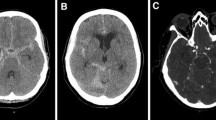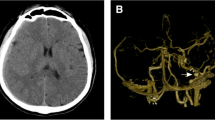Abstract
Introduction
Acute subdural hematoma (SDH) is an infrequent complication after aneurysmal subarachnoid hemorrhage. SDH associated with unruputed intracavernous aneurysm has never been reported.
Methods
Single patient case report and review of relevent literature.
Results
A 65-year-old woman with an unruptured, thrombosed giant intracavernous aneurysm developed an acute SDH 2 days after admission for cavernous sinus syndrome. Despite emergent evacuation of the SDH, the patient never regained consciousness because of brain herniation.
Conclusion
Acute SDH is a rare complication of ruptured, giant intracavernous aneurysms. Erosion of the cavernous sinus wall by acute enlargement of the aneurysm after thrombosis is the proposed mechanism for development of the SDH.
Similar content being viewed by others
References
Barr HWK, Blackwood W, Meadows SP. Intracavernous carotid aneurysms. Brain 1971;94:607–622.
Hodes JE, Fletcher WA, Goodman DF, et al. Rupture of cavernous artery aneurysm causing subdural hematoma and death. J Neurosurgery 1988;69:617–619.
Locksley HB. Natural history of subarachnoid hemorrhage, intracranial aneurysms and arteriovenous malformations. J Neurosurgery 1966;25:219–239.
Linskey ME, Sekhar LN, Hirsch W, et al. Aneurysms of the intracavernous carotid artery: clinical presentation, radiographic features and pathogenesis. Neurosurgery 1990;26(1):71–79.
Wilson BI. Bilateral saccular aneurysms of the internal carotid artery in the cavernous sinus. J Neurol Neurosurg Psychiatry 1963;26:174–177.
Morley TP, Barr HWK. Giant intracranial aneurysms: diagnosis, course and management. Clin Neurosurg 1968;15:73–94.
McLaughlin MR. Acute subdural hematoma caused by a ruptured giant intracavernous aneurysm: case report. Neurosurgery 1966;38:388–392.
Linskey ME, Sekhar LN, Hirsch W, et al. Aneurysms of the intracavernous carotid artery: natural history and indications for treatment. Neurosurgery 1990;26(6):933–938.
Whittle IR, Williams DB, Halmagyi GM, et al. Spontaneous thrombosis of a giant intracranial aneurysm and ipsilateral internal carotid artery. J Neurosurg 1982;56:287–289.
Drake CG. Giant intracranial aneurysms: experience with surgical treatment in 174 patients. Clin Neurosurg 1979;26:12–95.
Yashui T, Yagura H, Masaki K, et al. Mechanism of acute deterioration of the neurological status following rapid and massive intraluminal thrombosis in case of a giant intracavernous carotid artery aneurysm: demonstration by MR imaging. Surg Neurol 1993;40:51–56.
Author information
Authors and Affiliations
Corresponding author
Rights and permissions
About this article
Cite this article
Triantafyllopoulou, A., Beaumont, A., Ulatowski, J. et al. Acute subdural hematoma caused by an unruptured, thrombosed giant intracavernous aneurysm. Neurocrit Care 5, 39–42 (2006). https://doi.org/10.1385/NCC:5:1:39
Issue Date:
DOI: https://doi.org/10.1385/NCC:5:1:39




